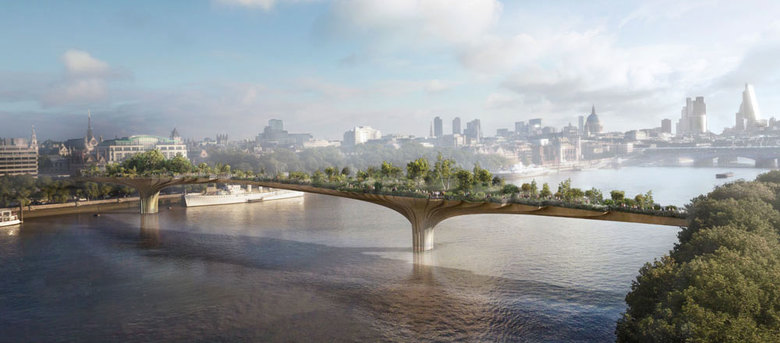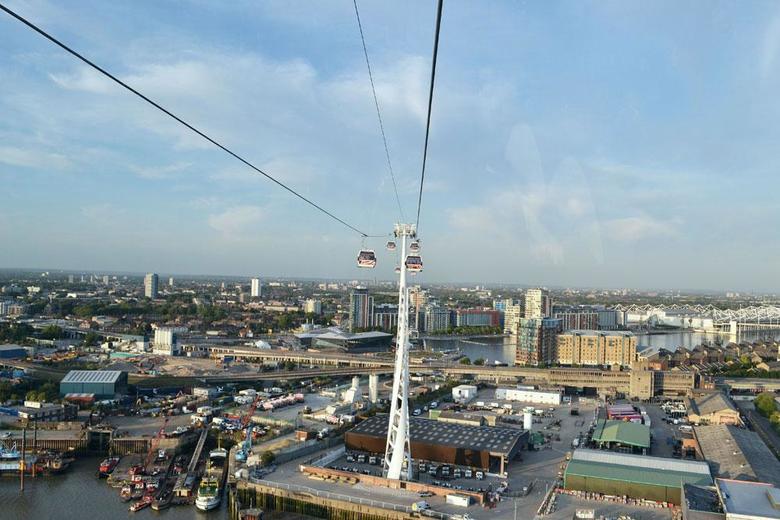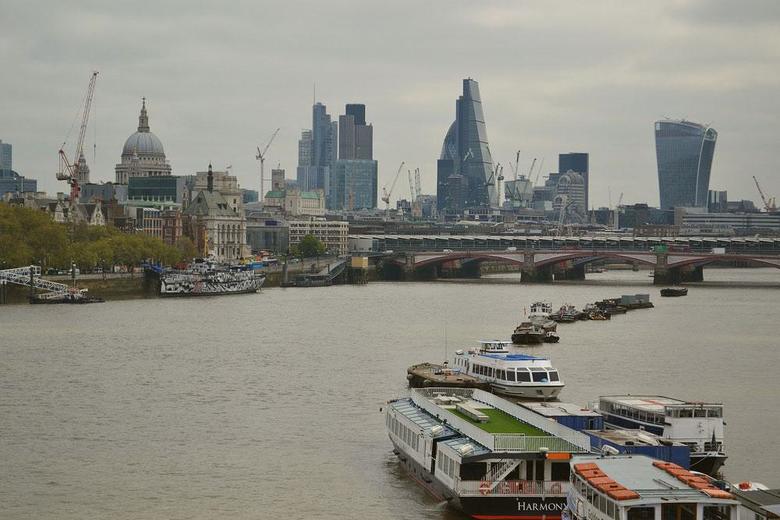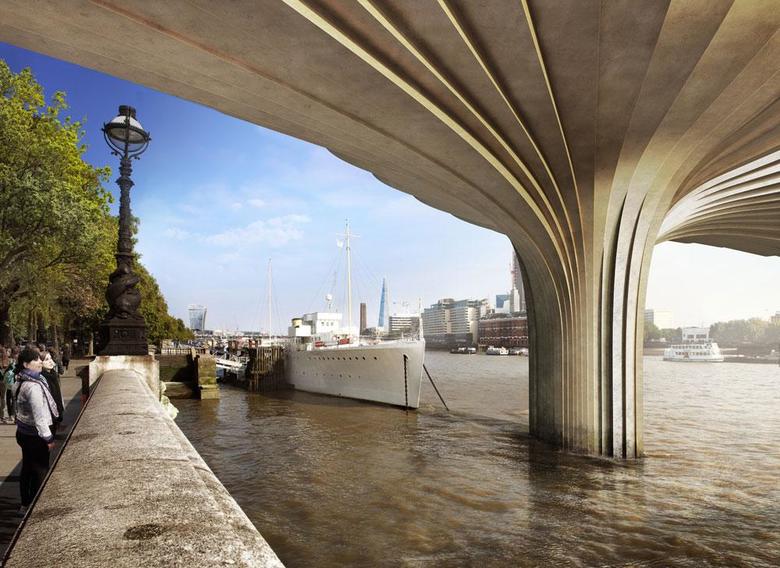The Mayor's New Bridge
Oliver Pohlisch
11. 5月 2015
Visualisierung der geplanten Garden Bridge
The Mayor of London, Boris Johnson, wants a green bridge crossing the Thames. Critics point out that the Garden Bridge would not be a public space. The fact that state funds are nevertheless channelled into its construction and maintenance has prompted them to take this case to court.
An urban Garden of Eden, with the waters of one of the world’s most famous rivers flowing underneath? This idea of a bridge divides London, although the structure should actually connect: namely both banks of the Thames. Many critics doubt that the planned Garden Bridge actually is a proper pedestrian bridge. They consider the construction to be nothing more than the last mark left behind by a mayor in love with himself and the architectural spectacle before striving for higher positions on a national level.
Boris Johnson, who seeks to obtain a mandate in the general elections on May 7, will resign from his position as Mayor of London in 2016. During the terms of the conservative politician, affordable housing space for the general public has become increasingly scarce in London, whilst he has generously approved high-rise tower projects of super-rich investors from China or the Middle East. Two hundred and sixty-three buildings with more than 20 floors are in the planning stage, notwithstanding the accusation that the mayor was selling out London. The city is already dubbed "Dubai on the Thames."
Furthermore, Johnson turned out to be a fan of over-dimensioned funfair architecture, placed in the cityscape by private investors. Thanks to him, Emirates Airline has operated a cable car crossing the river since 2012. In the same year, ArcelorMittal, the world’s largest steel producer, constructed Britain’s highest accessible sculpture, designed by Anish Kapoor, in the Olympic Park, after Johnson’s intercession.
The Town Hall gave the tree-covered Thames crossing the green light at the end of 2014 – shortly after the planning committees of the Lambeth and Westminster Districts had approved the construction. The Garden Bridge was devised by actress Joanna Lumley. In the 2000s, she already attempted to win over Johnson’s predecessor, Ken Livingstone, for the bridge project – back then, Lumley promoted it as a monument for deceased Lady Diana. The Labour politician, however, showed no interest.
That Johnson was by far more susceptive to Lumley’s project was perhaps down to the fact that designer Thomas Heatherwick conceived the bridge. After his cauldron for the Olympic flame for the 2012 Summer Olympics won high praise from all sides, he became the shooting star of his profession and above all, a favorite of the mayor. Johnson commissioned Heatherwick with the recent update of London’s traditional red double-decker bus. In 2013, Heatherwick won the competition for the Garden Bridge, which had been initiated by the non-profit London Garden Bridge Trust which had been specifically established for this purpose.
Themseüberquerung dank Luftseilbahn
1000 cubic meters of earth in two copper-nickel mushrooms
Heatherwick, currently involved in the implementation of the new Google headquarters in California, wants to implement the Garden Bridge together with engineers from Arup. Two gigantic mushrooms made of a copper-nickel alloy, as it is used for shipbuilding, shall spring from the Thames and support the bridge. The 1,000 cubic meters (35,300 cubic feet) of earth they will be filled with, Heatherwick believes, will make the difference in comparison to a concrete bridge, on which only plant containers would be set into holes.
The cost of the project is estimated at 175 million pounds (270 million USD). The London Garden Bridge Trust shall collect the majority of this amount from companies and affluent individuals. The donors can thus acquire the rights to the name of single garden plots. Landscape designer Dan Pearson will see to the planting of the bridge.
Heatherwick compares the project with New York’s High Line, a disused section of an elevated railway line in Manhattan, which had been left to rot for many years before it was converted into a park, thereby upgrading its surroundings. The area around the less frequented underground station Temple on the northern bank of the Thames was in need of a similar "beautification," believes Heatherwick. The 367-meter-long Garden Bridge shall span the Thames directly from the station roof to the National Theatre on the Southbank.
Although not a single bridge traverses the river east of the Tower Bridge (London keeps on expanding in this direction for dozens of kilometers on both sides of the Thames), the area close to the intended location of the Garden Bridge shows a relatively high density of bridges. The Garden Bridge would also impair the view from Waterloo Bridge to the City and St. Paul’s Cathedral, whose congregation firmly rejects the project. Additionally, the city’s silhouette would not be visible at all from the South Bank owing to the voluminous copper-nickel mushrooms standing in the water, fears Michael Bell, a former director of the Waterloo Community Development Group, a neighborhood organization that has been very active in planning processes related to the Southbank since the 1970s.
Bell, who has become one of the most vocal opponents of the bridge, asserts that the overall costs for the Garden Bridge would suffice to create green spaces of threefold the size elsewhere in London. Before the High Court, he succeeded to obtain a judicial review of the permission granted by the Lambeth District. Last month, a judge accepted Bell’s argument that the district had failed to sufficiently consider a potential gap in the funding of the bridge’s maintenance when coming to a decision. The judge criticized Mayor Johnson for his contradictory statements regarding an involvement of the public authorities. The High Court will carry out the review in June.
Actually, it seems as if the case of Garden Bridge repeats what already applied to the cable car and the accessible sculpture. Both were announced as private ventures, but received state funds nonetheless. For the Emirates Airline Cable Car alone, the city had to raise at least 24 million pounds after the initially estimated construction costs had been exceeded.
Allegedly, the London Garden Bridge Trust has by now been promised 65 million pounds from the pockets of affluent promoters. All the same, the Treasury will plough 30 million pounds to the construction of the bridge. Johnson, who praises the structure as a "fantastic oasis of quite in the heart of the city," warranted another 30 million from the budget of the municipal transport authority.
Although Johnson initially ruled out that Londoners would be asked to pay up for the maintenance of the bridge, it emerged in March that he had very well promised the trust to pay the annual operating expenses of 3.5 million pounds (5.5 million USD) from the city budget in case the sponsorship payments and revenues fail to appear.
Blick von der Warterloo Bridge auf das Nordufer der Themse mit St. Pauls Cathedral und City of London
Taliban-like hatred against beauty
The opponents of the Garden Bridge call the mayor’s and the Treasury’s support for the bridge a scandal. Funds which were normally reserved for local public transport projects were allocated to a construction, which upon completion could hardly be considered a public transport route.
Between midnight and six a.m., the bridge would be closed, cycling on the bridge would not be permitted and larger groups of people would have to announce their crossing in advance, and this will probably require an access with barriers. The London Garden Bridge Trust freely admits that this is an attempt to prevent protest on the bridge. The trust is also granted the right to block the bridge on twelve evenings per year for exclusive company events.
Bell and other critics are especially annoyed with the way the project was approved. Planning and procurement rules had been evaded with private letters to the mayor. The supervisory bodies had done their job inadequately. During question time at the City Parliament at the end of March, Johnson categorically rejected the demand for an independent review of the approval process.
This request was made by the parliamentary group leader of the Liberal Democrats, Caroline Pidgeon. She assumes that Joanna Lumley’s lobbying for the Garden Bridge had been successful with Johnson mainly due to her status as a friend of the family. She considered her accusation underpinned by a letter Lumley wrote to the mayor in 2010, in which the actress pointed out that she had already known Johnson since he was four years of age.
Above all, Pidgeon questioned the decision in favor of Heatherwick’s design. She criticized that in the selection procedure his studio had been rated higher in the category of design experience than the competitor Wilkinson Eyre, even though the latter has implemented more than 25 bridges and Heatherwick has only built one bridge so far.
Johnson, on the other hand, declared the procedure appropriate and fair. He called Pidgeon’s reasoning ridiculous, the majority of the jury had found Heatherwick’s concept sublime. Never at a loss for sharp comments, Johnson retorted that Pidgeon’s Taliban-like hatred against beauty was depressing.
One tourist attraction too many
If Heatherwick would be a genius à la Leonardo da Vinci, as Johnson and Lumley unfailingly attest, he would have rejected the proposed location for the Garden Bridge, thinks Michael Bell. On both sides of the river, the bridge ends rather abruptly. A height difference of eight meters (26 feet) to the ground necessitates a not exactly elegant phalanx of stairs. The Garden Bridge would lead from somewhere to nowhere and would make no reference to its environment. For visitors to the Southbank it would actually pose a safety risk, believes Bell. The daily flow of tourists brings the Southbank promenade to the limits of its capacity already. This additional attraction, for which the clients hope that it will be crossed by 7.1 million people every year, could cause dangerous congestions. On the Northbank, in turn, the project threatens to end the contemplative atmosphere around the Temple underground station.
Apart from that, the project also runs into headwind from a different side. Organizations such as the London Wildlife Trust and the Metropolitan Public Gardens Association sounded that the budgeted money would be a better investment spent elsewhere. It was not well received among environmental organizations that the controversial Glencore mining corporation intends to pay for the bridge’s copper-nickel alloy, a construction material that is also detrimental to a variety of fauna.
The Trust remains to be convinced of the benefits the bridges provides for the city at exactly the planned location. Not only would the bridge connect cultural venues and sights on both banks of the Thames, it also improves the safety of pedestrians, who could thanks to the bridge avoid congested routes in the future. The Trust also receives support from the current Secretary of State for Culture Ed Vaizey, who refers to the government grant for the structure as a sensible task. Star architect, Richard Rogers, too, thinks that the bridge is a wonderful idea enriching London.
Oliver Wainwright, architecture critic at The Guardian, griped to the contrary, saying that the Garden Bridge appeared like an aircraft carrier garnished with thin green snippets. It was exemplary for the strategy of real estate investors in London and elsewhere to obtain public consent for their in fact dreary, profane new building projects by sprinkling them with a bit of "urban parsley."
Bell wants to coax the national audit committee to review Finance Minister George Osborne’s pledge to promote the Garden Bridge with transportation project funds after the parliamentary election. So the bridge is likely to see at least a delay due to lengthy political and judicial disputes. Not only could this discourage additional and desperately needed sponsors, it could also lead to a collision with the construction of the so-called super-sewer tunnel along the Thames. The commencement of one of the largest infrastructure projects in Europe is scheduled for 2017, by then the closing of the shipping route for the construction of the central section of the Garden Bridge would have to be removed.
Ultimately, the opponents of the bridge hope that a changed political constellation in Westminster after May 7 could cut the ground from under the project’s feet. It is, however, not unlikely that the election result could bring Boris Johnson close to his actual goal: becoming Great Britain’s Premier. Should the Garden of Eden not stretch across the Thames by then, Johnson would certainly do everything in his power to eventually be the first person to walk across it.
Oliver Pohlisch is journalist, cultural scientist and member of metroZones - Zentrum für städtische Angelegenheiten in Berlin. He works as managing editor at taz.de.
This article originally appeared in German (translation by Bianca Murphy) as "Des Bürgermeisters neue Brücke" in the 29 April 2015 issue of the German-Architects eMagazin.
関連した記事
-
Heatherwick Studio to Turn BT Tower into Hotel
on 2024/02/22
-
Heatherwick's Coal Drops Yard Opens in London
on 2018/10/26
-
Disappear Here
on 2018/05/04
-
Canaletto Tower
on 2017/11/08
-
It's Official: Garden Bridge Is Dead
on 2017/08/14



